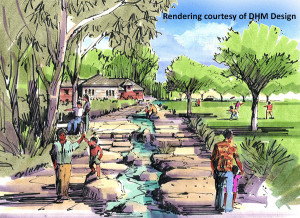What’s the Cost of Not Fixing a Brownfield? Plenty
 You’ve probably heard the term before: brownfield. What is a brownfield, beyond just, well, a brown field? According to the Environmental Protection Agency, a brownfield is a blighted property whose redevelopment may be complicated by real or perceived environmental contaminants. In other words, brownfields are community eyesores that need to be cleaned up. And that cleanup – while it can be very complicated – can lead to redevelopment, breathing new life into deteriorating areas. If done well, a brownfield redevelopment attracts private developers who are smart enough to see blossoming business opportunities.
You’ve probably heard the term before: brownfield. What is a brownfield, beyond just, well, a brown field? According to the Environmental Protection Agency, a brownfield is a blighted property whose redevelopment may be complicated by real or perceived environmental contaminants. In other words, brownfields are community eyesores that need to be cleaned up. And that cleanup – while it can be very complicated – can lead to redevelopment, breathing new life into deteriorating areas. If done well, a brownfield redevelopment attracts private developers who are smart enough to see blossoming business opportunities.
Our brownfield redevelopment practitioners are fond of saying “a brownfield is a grain of sand from which the pearl of a community develops.” That growth ultimately results in an increased tax base for the community and renewed momentum and motivation among residents and businesses.
On the flip side, let’s say a community can’t see the light at the end of the tunnel and decides it’s just going to live with its brownfields. While cleaning up brownfields can be costly, not cleaning them up can be even costlier:
- Unused properties are often undervalued or property tax delinquent. Not dealing with them means passing up tens of thousands of dollars in property taxes that a redeveloped property can bring in each year – not to mention the money flowing into the coffers from new jobs that are supporting home sales and sales tax generation.
- The properties surrounding the blighted properties will continue to decline in value as owners see little reason to fix up properties in depressed neighborhoods. (As a rule, brownfield redevelopment projects lead neighbors to spruce up their own properties, raising their value.)
- Businesses – especially professional, high-tech, and other lucrative firms – will continue to be repelled by brownfields that overshadow the positive quality of life that businesses and prospective employees would otherwise recognize in the community. (Eau Claire, Wisconsin, once affected by a decline in its industrial base, had an ugly downtown brownfield that is now home to Phoenix Park, JAMF Software, and a lively music scene. Outside magazine just named Eau Claire No. 4 on its list of the 16 Best Places to Live in America.)
- A village in Dane County, Wisconsin, is going through the very expensive process of pumping and air-stripping a brownfield area’s chlorinated-solvent-contaminated groundwater to remove the solvents by venting them into the air. The village successfully sued the party responsible for the contaminants, which ultimately shut down a nearby municipal well. Ayres Associates is now working with the village to redevelop the site to accommodate a neighboring business expansion.
 We’ll blog again in September about the various financial gains – as well as less tangible benefits – that a community stands to receive when it invests in brownfield redevelopment projects. But to whet your appetite, we’d like to tell you a little bit about a project that’s taking shape right now.
We’ll blog again in September about the various financial gains – as well as less tangible benefits – that a community stands to receive when it invests in brownfield redevelopment projects. But to whet your appetite, we’d like to tell you a little bit about a project that’s taking shape right now.
Ayres has been working with the City of Cheyenne, Wyoming, on its Cheyenne West Edge project, which is pictured in the three images in this post. This project brings together storm drainage management, brownfield redevelopment, and park amenities into one package designed to clean up a portion of the City’s western downtown area and spark economic development, such as new housing and businesses. To pay for this, Ayres has helped the City secure more than $16 million in funding for the project – and counting!
What does all this mean for Cheyenne? It means the City’s West Edge area near downtown already has started to get a much-needed facelift with the hope that this revitalization will continue to snowball. As a brownfield revitalization project, the project’s costs will be partially covered by grants. As a bonus, sorely needed stormwater, flooding, and drainage issues are being addressed. Any way you look at it, it’s a win for Cheyenne’s residents. To learn more about the Cheyenne West Edge project, and possibly get ideas for doing a similar project in your community, check out the Cheyenne West Edge website. It includes a nationally award-winning short video summarizing the project.
Are you thinking about your brownfield options? Scott Wilson, Ayres’ vice president of environmental services, will present “A Band, A Bar, A Brownfield: Creative Marketing for Engagement” at Brownfields 2015, a conference and trade show offering dozens of educational sessions from September 2-4 in Chicago. Scott, who will discuss brownfield projects in Wyoming, Colorado, and Arizona, also will be among the brownfield experts on a panel available for Q&A with conference attendees. If you can’t attend but would like to hear a little more about the process of greening up a brownfield, please view our brownfields video.
Comments
That is what my dad (and mom) does for a living, they’re environmental engineers. Nice article and good insight into the life of an environmental engineer. I can conclude that it is not for me, and if I may, I want to add my congratulations to mom and dad for the hard work they do in keeping our environment safe and clean.


Post a comment: